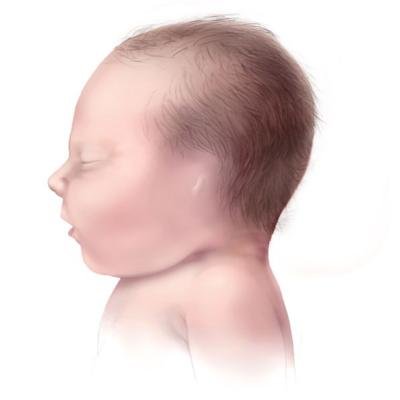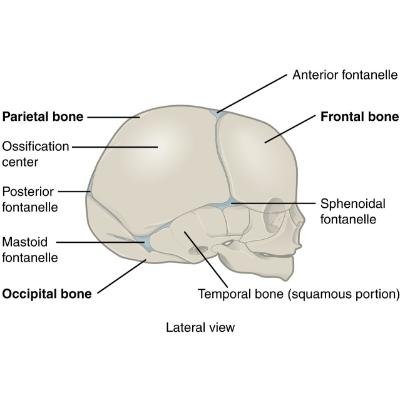The anatomy of the newborn skull is a vital aspect of early human development, as it plays a crucial role in accommodating the rapidly growing brain during the first stages of life. At birth, the human infant skull anatomy consists of several bones that are not yet fused, which allows for flexibility as the baby passes through the birth canal. This unique structure is characterized by various features, including newborn cranial sutures, which are the seams between these skull bones. The presence of these sutures facilitates safe passage during delivery and enables the skull to expand as the infant’s brain grows.
Common concerns regarding the shape of a newborn’s head often arise, with observations of elongated head shapes or flat areas on the skull. Such conditions might lead parents to seek solutions like a newborn helmet to shape head symmetry. It is important to recognize that these variations in newborn head shape are typically normal and may resolve on their own over time. Within the first few months, the soft skull newborn adjusts in shape due to natural molding and position changes, especially when the infant spends substantial time lying on their back.
The structure of the newborn skull, including its plates and sutures, is designed to promote healthy growth while safeguarding the brain. Understanding the anatomy of the newborn skull can dispel fears surrounding head shape irregularities, allowing caregivers to approach growth and developmental milestones with confidence. Being informed about minor concerns like uneven head shape in newborns can help parents differentiate between typical variations and potential issues requiring medical advice. In this blog post, we aim to delve deeper into the intricacies of the newborn skull, exploring its formation, development, and the importance of proper care to ensure optimal growth for infants.
Contents
- 1 Anatomy of Newborn Skull
- 2 Newborn Skull Shapes and Variations
- 3 Understanding Cranial Sutures
- 4 Causes of Uneven Head Shapes in Newborns
- 5 When to Consider a Helmet for Head Shaping
- 6 Newborn Skull Development Milestones
- 7 Tips for Caring for Your Newborn’s Head and Skull
- 8 When to Seek Medical Advice
- 9 Frequently Asked Questions
Anatomy of Newborn Skull
The anatomy of the newborn skull is a fascinating subject that reveals how the structure is designed to support the rapid growth and development of the brain in infants. At birth, the human infant skull consists of several key bones, primarily the frontal, parietal, temporal, and occipital bones. Understanding these components is crucial for recognizing how they contribute to the overall shape and function of the newborn head.
The frontal bone forms the forehead area and is essential for protecting the frontal lobes of the brain. Two parietal bones are located on either side of the skull, and they meet at the top of the head, providing a significant portion of the cranial cavity. The occipital bone, positioned at the base of the skull, houses the cerebellum and is integral in supporting the brain’s weight. The temporal bones flank the sides of the skull and play a role in protecting the auditory system and the structures associated with hearing.
One of the most unique features of the newborn skull is the presence of soft spots, known as fontanelles. These areas, where the cranial sutures—the fibrous joints connecting the skull bones—do not fully ossify, allow for flexibility during childbirth and later accommodate the rapid growth of the brain. The primary sutures include the sagittal, coronal, and lambdoid sutures, which facilitate the overlapping of bones during delivery, helping to ease the baby’s passage through the birth canal.
The anatomy of the newborn skull is also characterized by the arrangement of infant skull plates. These plates are not yet fused, which allows for a certain degree of movement and molding. Consequently, parents may observe variations in newborn head shape, such as elongated or uneven forms. While these changes are often normal during the early stages of life, they highlight the significance of monitoring newborn skull development as the infant grows.
Newborn Skull Shapes and Variations

The anatomy of a newborn skull is characterized by unique features that allow for molding during the birthing process. The human infant skull anatomy comprises several bones that are not yet fully fused, which is essential for facilitating passage through the birth canal. This anatomical characteristic often results in various newborn head shapes, the most common being the elongated head shape or cone-shaped skull. These shapes are typically temporary and result from the pressure exerted during delivery.
In the immediate weeks following birth, it is normal for a newborn’s head shape to change as the baby skull anatomy begins to adjust and adapt. The newborn cranial sutures, or joints between the bones, allow for flexibility, enabling the skull to be molded without causing harm. As the infant grows, their skull will gradually assume a more rounded shape, allowing for proper brain development. Parents may notice that their baby’s head shape appears uneven during the first few months; this is usually an indication of positional plagiocephaly, which can occur if the baby spends excessive time lying in one position.
It is important to note that variations in a newborn’s head shape can be influenced by several factors, including genetics and the birthing method. For instance, babies born via cesarean delivery may present a more rounded skull shape compared to those born vaginally, who are more likely to exhibit elongated head shapes due to the compressive forces during labor. Regardless of the initial head shape, it is crucial for parents to be mindful of the importance of tummy time and repositioning to encourage healthy cranial development and to prevent flat spots known as positional skull deformities.
While some parents may have concerns about their child’s newborn head shape, it is significant to remember that many forms are considered normal and temporary. Complications generally arise only in less common cases, where a newborn helmet to shape head may be recommended for certain extreme shapes or conditions. Overall, monitoring the normal development of the skull of newborn is essential, ensuring that the baby’s growth remains healthy and consistent.
Understanding Cranial Sutures
The newborn skull consists of various bones that are interconnected by fibrous joints known as cranial sutures. These sutures play a critical role in the anatomy of the infant skull, facilitating both growth and development. At birth, the principal sutures are the sagittal, coronal, and lambdoid sutures, along with the metopic suture. Each of these sutures contributes uniquely to the overall structure and flexibility of the new born skull.
Cranial sutures are essential for accommodating the rapid brain growth that occurs during the early stages of a child’s life. As the infant grows, the brain expands, and the sutures allow for slight movement between the skull bones. This provides the necessary space for the growing brain without causing undue pressure. In fact, the anatomy of newborn skull often exhibits a certain degree of flexibility, which is vital for a normal newborn skull development.
Importantly, these sutures begin to close gradually as the child matures. By the time an infant reaches around 18 months, the major sutures begin to ossify, meaning they convert from flexible fibrous tissue into solid bone. The closure of the newborn cranial sutures can vary among infants, and pediatricians monitor this process closely to ensure proper skull formation. Abnormalities in suture closure might lead to conditions such as craniosynostosis, where one or more sutures close prematurely, potentially resulting in an elongated head newborn or other irregular head shapes.
The normal shape of a newborn head can also be influenced by how sutures are shaped and their state of fusion. Attention to the shape and alignment of the baby’s head is crucial in assessing the health and development of the newborn skull. Understanding cranial sutures is thus paramount for parents and healthcare providers alike, as they form the foundation for healthy brain development and overall well-being in infants.
Causes of Uneven Head Shapes in Newborns
The shape of a newborn’s head, often referred to as the newborn skull, can exhibit variations that may cause concern for parents. Understanding the causes of these differences is crucial in distinguishing between normal anatomical variations and issues that may warrant professional evaluation. One common cause of an uneven head shape in infants is positional plagiocephaly. This condition occurs when a baby’s head develops a flat spot due to consistent pressure on one area, typically from lying in one position for extended periods. It is important to note that this form of head shape alteration does not generally indicate underlying problems with the skull structure itself.
Another significant factor influencing the newborn head shape is the infant’s sleeping position. Parents are often advised to place their babies on their backs during sleep to minimize the risk of Sudden Infant Death Syndrome (SIDS). While this is a critical safety measure, it can also lead to uneven head shapes if the baby develops a preference for turning their head to one side while sleeping. In such cases, adjustments to the sleeping position or supervision during awake hours can assist in encouraging more varied head positioning.
Environmental factors also play a role in newborn skull development. For instance, the type of crib mattress, activities like tummy time, or the amount of time spent in infant carriers versus being held can impact the distribution of pressure on different areas of the skull. It is worth noting that most variations in newborn head shape, including a long or flat skull, are typically normal and will resolve as the child grows and becomes more mobile. However, if a parent observes significant asymmetry or an unusual head shape, consulting a pediatrician can help determine whether a newborn helmet to shape head or other interventions may be necessary for optimal cranial development.
When to Consider a Helmet for Head Shaping
The newborn skull is a remarkable anatomical structure, specially designed to accommodate growth and development during infancy. However, some infants may experience irregular head shapes, such as flat spots or asymmetrical growth. These variations can be a result of factors like positioning during sleep, limited mobility, or even the natural molding that occurs during delivery. In such cases, parents may consider using a helmet for head shaping to promote a normal newborn head shape.
Signs that may indicate a baby might need a helmet include an observable flattening on one side of the newborn head, unevenness in the shape of the head, or elongated head structures that could result in further complications down the line. It is essential to consult with a pediatrician or a specialist who can assess the infant’s skull structure and development. They may recommend a thorough evaluation of the baby’s head molding and growth patterns before deciding if a helmet is appropriate.
The process of fitting a helmet for an infant typically involves the creation of a customized device that mirrors the shape of the child’s head. This helmet is engineered to provide a gentle, consistent pressure on the areas of the head that require reshaping, while allowing more space in areas that may be bulging. Adjustments are made periodically to ensure optimal fit and effectiveness, as the baby’s skull continues to develop and change. With proper use, helmets have been shown to significantly improve the overall head shape of infants, thus supporting healthy cranial development.
Ultimately, parents are encouraged to monitor their child’s head shape and consult healthcare professionals if they notice any irregularities. Early intervention can yield better outcomes in achieving a desirable shape for the newborn skull, allowing for normal development as the child grows.
Newborn Skull Development Milestones
The development of the newborn skull is a critical aspect of an infant’s growth, as it lays the foundation for overall brain development and head shape. At birth, a newborn’s skull is soft and pliable, comprised of several distinct bones known as skull plates. These plates are separated by flexible regions called cranial sutures, which allow for growth and enable the skull to conform to the birth canal during delivery. The anatomy of the newborn skull is designed to accommodate significant changes during the first year of life, reflecting the rapid brain development that occurs during this period.
In the initial weeks following birth, the newborn head shape may appear somewhat elongated or cone-like, due to the molding experienced during labor. By around 2 to 3 months of age, parents can expect these initial distortions to begin to correct themselves as the infant’s skull bones shift into a more normal shape. During this time, the major cranial sutures, such as the sagittal and coronal sutures, remain flexible, facilitating head shape changes as necessary.
By the age of 6 months, most infants will show distinct signs of head shape normalization, although some may experience uneven head shapes. In cases where a baby’s head shape shows significant flattening, a newborn helmet may be recommended by pediatricians to aid in reshaping. As the infant approaches their first birthday, parents can expect the sutures to begin closing, with the anterior fontanelle typically closing by 18 to 24 months. Maintaining awareness of these developmental milestones helps caregivers understand the normal newborn skull formation and promotes proactive discussions with healthcare professionals regarding any concerns related to head shape or skull development.
Tips for Caring for Your Newborn’s Head and Skull
Caring for your newborn’s head and skull is crucial to ensure proper development and to prevent issues such as flat head syndrome or an uneven head shape. Newborn skulls are soft and malleable, consisting of several plates that allow for compression during birth, but providing appropriate care is essential for healthy growth. Here are some practical tips to promote your infant’s healthy skull development.
One of the most important practices is to follow safe sleep guidelines. Always place your newborn on their back to sleep, as this position has been shown to reduce the risk of Sudden Infant Death Syndrome (SIDS). Additionally, avoid placing any soft bedding, pillows, or toys in the crib that could pose a suffocation risk. You should also change the baby’s head position during sleep hours to encourage even pressure distribution on the skull. Try alternating which end of the crib the baby’s head is at each night.
During playtime, facilitate a variety of positions. Encourage your infant to spend time on their tummy while awake, known as tummy time, which can help improve neck strength and promote better head shape development. Placing toys just out of reach can motivate them to turn and position their head differently, increasing the variability in head positioning. It’s important to hold your baby and carry them in various positions to further ensure they are not always resting their head in the same spot.
If you notice an uneven head shape or flat spots forming, consult with your pediatrician for guidance. They may recommend special therapies or even a newborn helmet to shape the head if necessary. Remember, monitoring and encouraging a normal newborn skull development is an ongoing process that involves attentiveness and adjustments to habits and routines.
When to Seek Medical Advice
Parents play a crucial role in monitoring their newborn’s development, particularly concerning the shape and structure of the newborn skull. A vast majority of infants exhibit typical head shapes due to the inherent flexibility of their skull bones, which are designed to mold during the birthing process. However, there are certain signs that necessitate immediate consultation with a pediatrician to rule out potential abnormalities in the anatomy of the infant skull.
One key indication for seeking medical advice is the appearance of an elongated head during the initial weeks of life, often referred to as “cone head.” While some asymmetry is common and may resolve on its own, an excessively misshapen skull could signal a condition known as positional plagiocephaly or, in more severe cases, craniosynostosis, which occurs when one or more of the newborn cranial sutures fuse too early. Parents should also be vigilant for an uneven head shape, which can affect the baby’s head shape and overall appearance.
Moreover, if the infant exhibits noticeable differences in head growth or developmental delays in motor skills, immediate consultation is recommended. An observable decrease in head circumference growth or an unexpected increase can be red flags in monitoring normal newborn skull development.
This proactive approach is part of ensuring the healthy development of the newborn skull and detecting issues early on. Parents should not hesitate to discuss any concerns about their baby’s head shape or signs of discomfort, as pediatricians are equipped to assess and recommend appropriate interventions, such as the usage of a newborn helmet to shape head appropriately if necessary.
Overall, staying informed and aware of the crucial signs associated with the normal anatomy of newborn skulls can facilitate timely medical consultations, ensuring that any necessary care is administered promptly.
Frequently Asked Questions
Here are some common questions:
When is a baby’s skull fully developed?
Structural protection for a child’s brain is completed at 2 years old.

